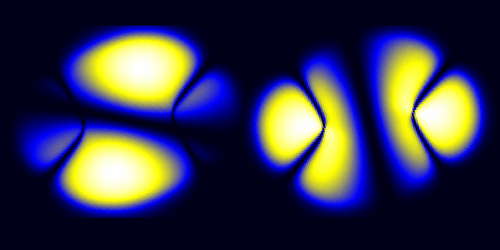Deciphering Single-Molecule Fluorescence
Scanning tunneling microscopes (STMs) let physicists peer at individual fluorescent molecules with close-to-atomic resolution. But the detailed mechanism by which a molecule emits light under stimulation by an STM remains debated, because observations do not indicate what spin and charge states the excited molecule transits through before it decays to the ground state. Providing key information toward resolving this debate, Song Jiang, of the University of Strasbourg, France, and his colleagues have conducted an experiment and developed a model to relate the molecule’s charge state to the emitted light energy [1].
In the team’s experiment, an STM tip drives a current across a quinacridone (QA) molecule adsorbed on a thin insulating film layered upon a metal substrate. A rare property of QA is that its neutral and positively charged states have distinct emission patterns, with the orientation of the molecule’s fluorescent dipoles differing by 65 degrees. While scanning the material with an STM tip across different voltage ranges, the researchers created sub-nanometer-resolution fluorescence maps. From the patterns in these maps, they could determine the orientation of the dipole that fluoresced—and, hence, the molecule’s charge state—at a given moment. They then established a model describing the details of the electron transport and light emission based on the STM current and voltage as well as on the spatial dependency of an STM-induced fluorescence signal.
The study demonstrates that, depending on the applied voltage, a single molecule on a substrate can hold four different charge states. It additionally provides a way to distinguish between phosphorescence and current-driven luminescence of charged molecules. The authors say the model can be generalized to any organic system adsorbed on a thin film.
–Rachel Berkowitz
Rachel Berkowitz is a Corresponding Editor for Physics Magazine based in Vancouver, Canada.
References
- S. Jiang et al., “Many-body description of STM-induced fluorescence of charged molecules,” Phys. Rev. Lett. 130, 126202 (2023).




